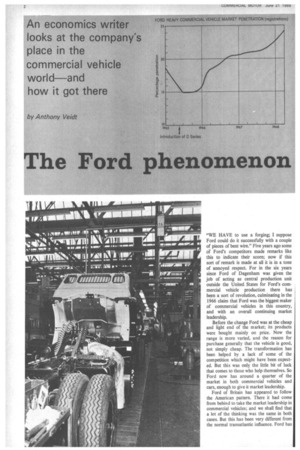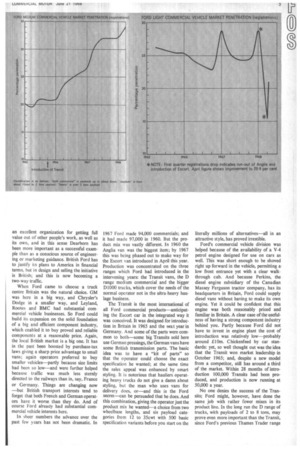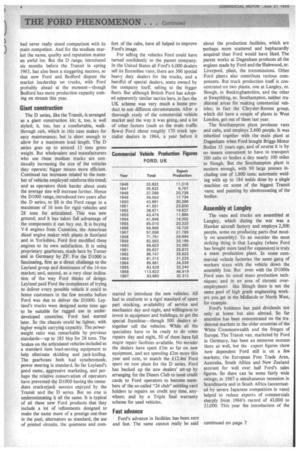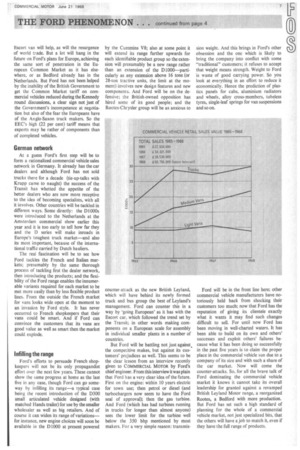The Ford phenomenon
Page 4

Page 5

Page 6

Page 9

If you've noticed an error in this article please click here to report it so we can fix it.
"WE HAVE to use a forging; I suppose Ford could do it successfully with a couple of pieces of bent wire." Five years ago some of Ford's competitors made remarks like this to indicate their scorn; now if this sort of remark is made at all it is in a tone of annoyed respect. For in the six years since Ford of Dagenham was given the job of acting as central production unit outside the United States for Ford's commercial vehicle production there has been a sort of revolution, culminating in the 1966 claim that Ford was the biggest maker of commercial vehicles in this country, and with an overall continuing market leadership.
Before the change Ford was at the cheap and light end of the market; its products were bought mainly on price. Now the range is more varied, and the reason for purchase generally that the vehicle is good, not simply cheap. The transformation has been helped by a lack of some of the competition which might have been expected. But this was only the little bit of luck that comes to those who help themselves. So Ford now has around a quarter of the market in both commercial vehicles and cars, enough to give it market leadership.
Ford of Britain has appeared to follow the American pattern. There it had come from behind to take the market leadership in commercial vehicles; and we shall find that a lot of the thinking was the same in both cases. But this has been very different from the normal transatlantic influence. Ford has
an excellent organization for getting full value out of other people's work, as well as its own, and in this sense Dearborn has been more important as a successful example than as a conscious source of engineering or marketing guidance. British Ford has to justify its plans to America in financial terms, but in design and selling the initiative is British; and this is now becoming a two-way traffic.
When Ford came to choose a truck centre Britain was the natural choice. GM was here in a big way, and Chrysler's Dodge in a smaller way, and Leyland, Rootes and BMC had substantial commercial vehicle businesses. So Ford could build its expansion on the solid foundation Of a big and efficient component industry, which enabled it to buy proved and reliable components at a reasonable price. Again, the local British market is a big one. It has in the past been boosted by purchase-tax laws giving a sharp price advantage to small vans; again operators preferred to buy smaller vehicles—partly because size limits had been so low—and were further helped because traffic was much less sternly directed to the railways than in, say, France or Germany. Things are changing now —but British transport interests tend to forget that both French and German operators have it worse than they do. And of course Ford already had substantial commercial vehicle interests here.
In sheer numbers the advance over the past few years has not been dramatic. In
1967 Ford made 94,000 commercials; and it had made 97,000 in 1960. But the product mix was vastly different. In 1960 the Anglia van was the biggest item; by 1967 this was being phased out to make way for the Escort van introduced in April this year. Production was concentrated on the three ranges which Ford had introduced in the intervening years: the Transit vans, the D range medium commercial and the bigger D1000 trucks, which cover the needs of the normal operator not in the ultra-heavy haulage business.
The Transit is the most international of all Ford commercial products—anticipating the Escort car in the integrated way it was conceived. It was designed for introduction in Britain in 1965 and the next year in Germany. And some of the parts were common to both—some big Transits sold here use German pressings, the German vans have some British transmission parts. The basic idea was to have a "kit of parts" so that the operator could choose the exact specification he wanted; at the same time the sales appeal was enhanced by smart styling. It is notorious that hauliers operating heavy trucks do not give a damn about styling, but the man who uses vans for delivery does, or—and this is the Ford secret—can be persuaded that he does. And this combination, giving the operator just the product mix he wanted—a choice from two wheelbase lengths, and six payload categories from 12 to 35cwt with 500 basic specification variants before you start on the literally millions of alternatives—all in an attractive style, has proved irrestible.
Ford's commercial vehicle division was helped because of the availability of a V-4 petrol engine designed for use on cars as well. This was short enough to be shoved right up forward in the vehicle, permitting alow front entrance yet with a clear walkthrough cab. And because Perkins, the diesel engine subsidiary of the Canadian Massey Ferguson tractor company, has its headquarters in Britain, Ford could supply diesel vans without having to make its own engine. Yet it could be confident that this engine was both reasonably priced and familiar in Britain. A clear case of the usefulness of having a strong component industry behind you. Partly because Ford did not have to invest in engine plant the cost of introduction was relatively low—probably around £10m. Chickenfeed by car standards: yet, so well thought out was the idea that the Transit won market leadership in October 1965; and, despite a new model from a competitor, still has around a third of the market. Within 28 months of introduction 100,000 Transits had been produced, and production is now running at 50,000 a year.
No one denies the success of the Transits; Ford might, however, have done the same job with rather fewer mixes in its product line. In the long run the D range of trucks, with payloads of 2 to 8 tons, may prove even more important than the Transit, since Ford's previous Thames Trader range had never really stood comparison with its main competitor. And for the medium market the name, quality and reputation matter an awful lot. But the D range, introduced six months before the Transit in spring 1965, has also been a staggering success, so that now Ford and Bedford dispute the market leadership on trucks, with Ford probably ahead at the moment-though Bedford has more production capacity coming on stream this year.
Giant construction The D series, like the Transit, is arranged as a giant construction kit; it, too, is well styled; it, too, has a comfortable, walkthrough cab, which in this case makes for easy maintenance; but is short enough to allow for a maximum load length. The D series goes up to around 13 tons gross weight. But wholesalers and manufacturers who use these medium trucks are continually increasing the size of the vehicles they operate; bigger means more efficient. Continual tax increases related to the number of vehicles employed reinforce this trend; and as operators think harder about costs the average size will increase further. Hence the D1000 range, introduced two years after the D series, to fill in the Ford range to a maximum of 16 tons for rigid vehicles and 28 tons for articulated. This was new ground; and it has taken full advantage of the components it can buy out. It is buying V-8 engines from Cummins, the American diesel engine maker with plants in Scotland and in Yorkshire. Ford first modified these engines to its own satisfaction. It is using proprietary gearboxes, made here by Turner and in Germany by ZF. For the D1000 is fascinating, first as a direct challenge to the Leyland group and dominance of the 16-ton market; and, second, as a very clear indication of the way Ford thinks of design. Leyland paid Ford the compliment of trying to deliver every possible vehicle it could to home customers in the few months before Ford was due to deliver the D1000. Leyland's trucks were designed some time ago to be suitable for rugged use in underdeveloped countries; Ford had started later. So the chassis could be lighter, with higher weight carrying capacity. The powerweight ratio was remarkable by previous standards-up to 185 bhp for 28 tons. The brakes on the articulated vehicles included as a standard item load-sensing equipment to help eliminate skidding and jack-knifing. The gearboxes both had synchromesh; power steering is standard. So far Leyland's good name, aggressive marketing, and perhaps the relative conservatism of operators have prevented the D1000 having the immediate crackerjack success enjoyed by the Transit and the D series. But no one is underestimating it all the same. It is typical of all these new Ford products that they include a lot of refinements designed to make the name more of a prestige one than in the past; alternators as standard, the use of printed circuits, the quietness and corn
fort of the cabs, have all helped to improve Ford's image.
For selling the vehicles Ford could have turned confidently to the parent company. In the United States all Ford's 6,000 dealers sell its Econoline vans; there are 300 special heavy duty dealers for the trucks, and a handful of special dealers, some owned by the company itself, selling to the bigger fleets. But although British Ford has adopted apparently similar tactics here, in fact the UK scheme was very much a home product to suit different circumstances. After a thorough study of the commercial vehicle market and the way it was going,.and a lot of other factors (such as the main traffic flows) Ford chose roughly 170 truck specialist dealers in 1964, a year before it
started to introduce the new vehicles. All had to conform to a rigid standard of spare part stocking, availability of service and mechanics day and night, and willingness to invest in equipment and buildings, to get the special franchise-though 500 dealers altogether sell the vehicles. While all the specialists have to be ready to do some repairs day and night, 50 of them have full major repair facilities available. No wonder the dealers have spent £5m so far on new equipment, and are spending £2m more this year and next, to match the £12.4m Ford spent on new plant for the D series. Ford has backed up the new dealers' set-up by arranging for the Diners Club to issue credit cards to Ford operators to become members of the so-called "24 club" entitling card holders to repairs on credit any time, anywhere; and by a Triple Seal warranty scheme for used vehicles.
Fast advance
Ford's advance in facilities has been sure and fast. The same cannot really be said about the production facilities, which are perhaps more scattered and haphazardly acquired than Ford would have liked. The parent works at Dagenham produces all the engines made by Ford and the Halewood, nr. Liverpool, plant, the transmissions. Other Ford plants also contribute various components. But truck production itself is concentrated on two plants, one at Langley, nr. Slough, in Buckinghamshire, and the other at Swaythling, nr. Southampton, neither traditional areas for making commercial vehicles; in fact the Chrysler-Rootes group, which did have a couple of plants in West London, got out of them last year.
The Southampton plant produces vans and cabs, and employs 2,600 people. It was inherited together with the main plant at Dagenham when Ford bought Briggs Motor Bodies 15 years ago, and of course it is by no means convenient to have to transport 300 cabs or bodies a day nearly 100 miles to Slough. But the Southampton plant is modern enough, with 90 large presses including one of 1,800 tons; automatic welding with up to 184 welds done by a single machine on some of the biggest Transit vans; and painting by electrocoating of the bodies.
Assembly at Langley
The vans and trucks are assembled at Langley, which during the war was a Hawker aircraft factory and employs 2,300 people, some on producing parts (but mostly on assembly). To an outsider the most striking thing is that Langley (where Ford has bought more land for expansion) is truly a mass production plant. In some commercial vehicle factories the same gang of workers stays with the vehicle down the assembly line. But even with the D1000s Ford uses its usual mass production techniques, and in an area of chronic overemployment like Slough there is not the same pool of high grade engineering workers you get in the Midlands or North West, for example.
Ford's boldness has paid dividends not only at home but also abroad. So far attention has been concentrated on the traditional markets in the older countries of the White Commonwealth and the fringes of Europe. The Transit van, marketed by Ford in Germany, has been an immense success there as well, but the export figures show how dependent Ford still is on a few markets; the European Free Trade Area, Australia, South Africa and New Zealand account for well over half Ford's sales figures. So there can be some fairly wide swings; in 1967 a simultaneous recession in Scandinavia and in South Africa (accentuated by severe Japanese competition in vans) helped to reduce exports of commercials sharply from 1966's record of 43,000 to 33,000. This year the introduction of the Escort van will help, as will the resurgence of world trade. But a lot will hang in the future on Ford's plans for Europe, achieving the same sort of penetration in the European Common Market as it has elsewhere, or as Bedford already has in the Netherlands. But Ford has not been helped by the inability of the British Government to get the Common Market tariff on commercial vehicles reduced during the Kennedy round discussions, a clear sign not just of the Government's incompetence at negotiation but also of the fear the Europeans have of the Anglo-Saxon truck makers. So the EEC's high (22 per cent) tariff means that exports may be rather of components than of completed vehicles.
German network At a guess Ford's first step will be to form a rationalized commercial vehicle sales network in Germany. It already has the car dealers and although Ford has not sold trucks there for a decade (tie-up-talks with Krupp came to naught) the success of the Transit has whetted the appetite of the better dealers who are now more receptive to the idea of becoming specialists, with all it involves. Other countries will be tackled in different ways. Some directly: the D1000s were introduced to the Netherlands at the Amsterdam commercial show earlier this year and it is too early to tell how far they and the D series will make inroads in Europe's toughest truck market—and also its most important, because of the international traffic carried by Dutch hauliers.
The real fascination will be to see how Ford tackles the French and Italian markets; presumably by the same thorough process of tackling first the dealer network, then introducing the products; and the flexibility of the Ford range enables the innumerable variants required for each market to be met more easily than by less flexible product lines. From the outside the French market for vans looks wide open at the moment to an invasion by Ford style. It has never occurred to French shopkeepers that their vans could be smart. And if Ford can convince the customers that its vans are good value as well as smart then the market could explode.
I nfilli ng the range Ford's efforts to persuade French shopkeepers will not be its only propagandist effort over the next few years. These cannot show the same progress at home as the last five in any case, though Ford can go someway by infilling its range—a typical case being the recent introduction of the D300 small articulated vehicle designed (with matched Hands trailer) for use by the smaller wholesaler as well as big retailers. And of course it can widen its range of variations— for instance, new engine choices will soon be available in the 01000 at present powered by the Cummins V8; also at some point it will extend its range further upwards for each identifiable product group so the extension will presumably be a new range rather than an extension of the D1000—particularly as any extension above 16 tons (or 28-ton tractive units, the limit at the moment) involves new design features and new components. And Ford will be on the defensive; the British-owned opposition has hired some of its good people; and the Rootes-Chrysler group will be as anxious to counter-attack as the new British Leyland, which will have behind its newly formed truck and bus group the best of Leyland's management. Ford can counter this in a way by 'going European' as it has with the Escort car, which followed the trend set by the Transit; in other words making components on a European scale for assembly in individual smaller plants in a number of countries.
But Ford will be battling not just against, the competitive makes, but against its customers' prejudices as well.-This seems to be the clear lesson from an interview recently given to COMMERCIAL MOTOR by Ford's chief engineer. From this interview it was plain that Ford has a very clear idea of the future. First on the engine: within 10 years electric for town use; then petrol or diesel (and turbochargers now seem to have the Ford seal of approval); then the gas turbine. And Ford (which has had turbines running in trucks for longer than almost anyone) sees the lower limit for the turbine well below the 350 bhp mentioned by most makers. For a very simple reason: transmis
sion weight. And this brings in Ford's other obsession and the one which is likely to bring the company into conflict with some "traditional" customers; it refuses to accept that weight means strength. Weight to Ford is waste of good carrying power. So you look at everything in an effort to reduce it economically. Hence the prediction of plastics panels for cabs, aluminium radiators and wheels, alloy cross-members, tubeless tyres, single-leaf springs for van suspensions and so on.
Ford will be in the front line here; other commercial vehicle manufacturers have notoriously held back from shocking their customers too much; now that Ford has the reputation of giving its clientele exactly what it wants it may find such changes difficult to sell. For until now Ford has been moving in well-charted waters. It has been able to build on its own and others' successes and exploit others' failures be-cause what it has been doing so successfully in the past five years is to claim the proper place in the commercial vehicle sun due to a company of its size and with such a share of the car market. Now will come the counter-attacks. So, for all the brave talk of Ford dominating the commercial vehicle market it knows it cannot take its overall leadership for granted against a revamped British Leyland Motor range, a reorganized Rootes, a Bedford with more production. But Ford has set such a high standard of planning for the whole of a commercial vehicle market, not just specialized bits, that the others will have a job to match it, even if they have the full range of products.








































































































































































































